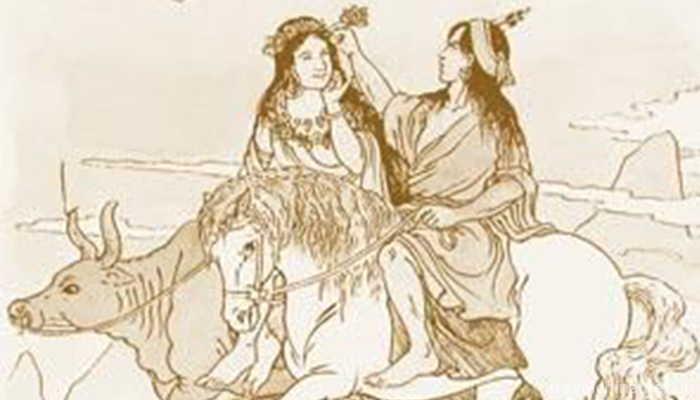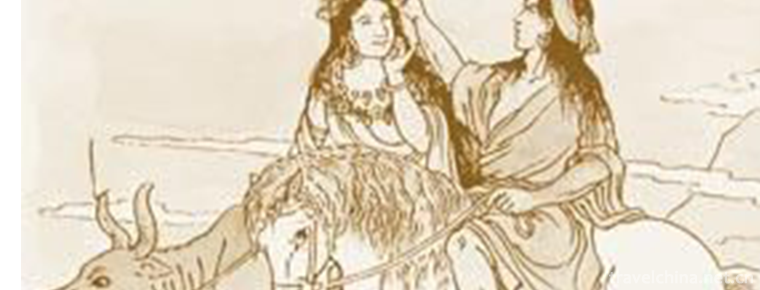Legend of the ancestors of Khitan
Legend of the ancestors of Khitan
The legend of the ancestors of Qidan is a folk legend that is spread in Pingquan County, Hebei Province, China. According to legend, the ancestors of Qidan were born on the Futu River in Mayushan, Pingquan County by "gods and men riding on white horses" and formed "eight parts of Qidan". The legend has a long history and great influence in Pingquan County. This is the origin of the funeral custom of local men pasting white horses and women pasting green cattle in later generations.
On May 23, 2011, the legend of Qidan's ancestors was approved by the State Council to be included in the third batch of national intangible cultural heritage list.
Historical Origin
Qidan is an ancient nation in China. It was founded in Liao Dynasty (916-1125). At the latest in the early years of the Northern Wei Dynasty, the name of Qidan was recorded in the literature. The earliest biography of Qidan was Wei Shu, which said: "The kingdom of Qidan, in Kumoxidong, is a heterogeneous kingdom, all fleeing between the Songmo desert. In the process of landing, the army broke down and fled, sharing with Cuomo. After decades of growth, there are tribes, hundreds of miles north of Helong, mostly bandits. According to the biography of Wei Shu Kumoxi, the story of Xie and Qidan in the Northern Wei Dynasty was first published in Tuoba, Taizu, for three years (388). At that time, the so-called Khitan State was only a statement of different tribes or regions recorded in historical records, and it did not really establish a strict state system. The founding of Khitan was seen more than 500 years later in historical records, that is, in 916 AD, Jerusalem Abaoji.“
The Supreme Honour calls it the Great Saint Tomorrow Emperor, and later the Empress of the Daming Earth, the Amnesty, the Founding of the Sovereign Book. It abolishes the electoral system of Khitan Khan, establishes the hereditary system of imperial power, and formally establishes an autocratic country.
The legend of Qidan's ancestors has a long history. "History of Liao Dynasty" Volume 37, Geographic Records 1, Zhi 7, there are records about it: "Legend has it that the goddess rides a white horse, from the Futu River east of Mayu Mountain, the goddess drives a green ox cart from Pinus tabulaeformis Panhuang River down to Muye Mountain, where two rivers merge, meet as a spouse and have eight sons, and the descendants are gradually divided into eight parts. Every March and sacrifice in the Spring and Autumn Period, the white horse and the green ox must be used to show that the original cloud is not forgotten. This is the origin of the earliest "eight tribes of Qidan". Their tribes worship the green cattle and white horses to show their ancestors'worship.
This legend has been spread orally in Pingquan County and its surrounding areas. The tombs of Dachang princess, Shiyang Shihu Liao ancient tombs, Dou Jingyong's tomb, Deputy envoy of Liao Privy Council, and legends about Liao Dynasty, especially the local unearthed relics of Liao Dynasty, such as Liao Sancai, Longfeng pattern gold and silver wares, can prove that the Qidan people really live and multiply in this land.
Pingquan County has a long history. Since ancient times, there has been a saying that "three provinces call chickens, Tongqu Liao Meng". In Liao Dynasty, it was called Shenshan County. Shenshan was the meaning of the mountain where God and man lived. From the records of Liao Shi and Chengde Fu Zhi, it can be fully confirmed that Mayushan (Guangtoushan, Liuxi Township) is indeed the birthplace of the ancestors of Qidan and the birthplace of the Qidan nationality. The funeral custom of pasting white horses for men and green cattle for women is still popular. With the passage of time, the man's death is still pasted white horse, and the woman's death has changed from pasted green cattle to pasted yellow cattle.
Ethnic background
The Qidan nationality is an ancient ethnic group in northern China, which has existed for more than 1,000 years. The Liao Dynasty established by Qidan lasted for nine emperors. In 209, it had a vast territory, equivalent to two Northern Song Dynasty. After the extinction of Liao Dynasty in the Jin Dynasty, Yelu Dashi led part of the Qidan people to travel west for ten thousand miles. Today, in Xinjiang and Central Asia, China has established the Western Liao Dynasty for more than ninety years. Liao (Northern Liao) and Western Liao together for more than 300 years.
Inheritance Significance
The legend of green cattle and white horse has a great influence in Pingquan. The funeral custom of the local men and women pasting white horse and green cattle came from this. Its main value includes the following four aspects:
Historical value: It proves from one side that the ancestors of Qidan were born and originated in Pingquan, which plays an irreplaceable role in the study of the origin of the Qidan nationality.
Cultural value: Through rescuing, excavating and protecting the legend, we can find out the situation of inheritance in different groups and enrich the local cultural connotation.
Academic value: "Qingniu Baima" may be a totem, through its research, we can further uncover the mystery of funeral customs and enrich the content of folklore knowledge.
Economic Value: The legendary site of the ancestors of Qidan is Mayushan, which is the seat of Liaoheyuan National Forest Park. Through this legend, promote the development of Pingquan tourism and increase economic income.


-
1.Pumpkin rice gruel
cut Pumpkin Peel into thin slices and rinse with millet. Put some water in the pot, put water into pumpkin millet and boil it in a big heat.
Time 2018-11-02 -
2.Park hyatt Guangzhou
In Guangzhou Park Hyatt Hotel, a traditional Lingnan culture and Gourmet Tour is opened. Guangzhou Baiyue Hotel integrates Lingnan's long history and culture with Baiyue's delicate modern
Time 2018-12-16 -
3.Baiyundong Tourist Area Kongshan
Baiyundong in Kongshan Mountain is a national key scenic spot, National Geological Park and national AAAA level scenic spot. Located in Lincheng County of Xingtai City
Time 2019-01-29 -
4.Langyatai Scenic Area
Langyatai Scenic Spot belongs to Qingdao Langyatai Provincial Tourism Resort (established in December 1995 with the approval of Shandong Provincial People's Government with a planned area of 9.8 squar
Time 2019-01-29 -
5.Chaozhou Music
Chaozhou music is the general name of all kinds of traditional folk instrumental music spread in Chaoshan area of Guangdong Province, referred to as Chaozhou music
Time 2019-04-16 -
6.Two strands
Erguxian is an ancient traditional opera, which was formed in Song Dynasty and has a history of more than 500 years. The two-strand string is evolved from folk minor,
Time 2019-04-28 -
7.Kazakhstan 62 Kwohner
Kazakhstan 62 Kwohner 62 Kwohner is Kazakh folk classical music, which means "62 suites". It is a comprehensive art mainly composed of instrumental music, accompanied by folk songs, dances,
Time 2019-05-02 -
8.Nanjing White Bureau
Nanjing Baiju is an ancient type of music in Nanjing area. The "Nanjing tune" in the Yuanqu brand is the original tune of Baiju's ancient tune. It has a history of more than 700 years. It wa
Time 2019-06-07 -
9.Nanxi chant
Nanxi chant is popular in Qianjiang District of Chongqing City. Its origin can be traced back to Tang Dynasty. Its embryonic form is Tujia peasants'work chant and folk song chant, which are similar to
Time 2019-06-07 -
10.Pinghu cymbal book
Cymbals are a unique form of local traditional folk art in the Wu dialect area of Jiangnan. According to the Records of Songjiang County, it was formed in the Qing Dynasty (1821-1850). It is now mainl
Time 2019-06-09 -
11.Xinchang tune
Xinchang tune is one of the ancient opera tunes, also known as "falling out of tune", "Shaoxing high-key" and "Xinchang high-key". With Xinchang as the center, it has spr
Time 2019-07-06 -
12.Cultural corridor of Confucianism Buddhism and Taoism
Emei Mountain Confucian, Buddhist and Taoist cultural corridor inherits and develops Chinese traditional culture through different aspects, and excavates its own value and charm from Emei Mountain's historical culture, and highlights its connotation of "China's first mountain".
Time 2020-10-15